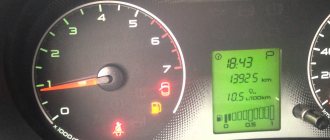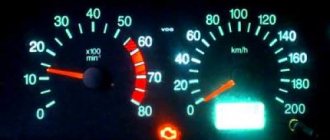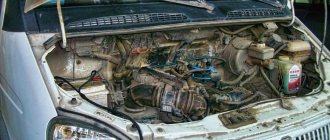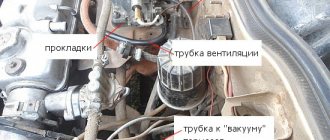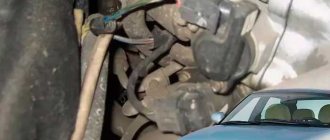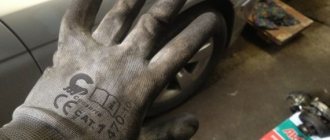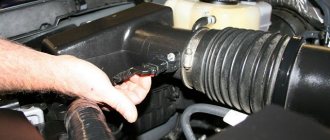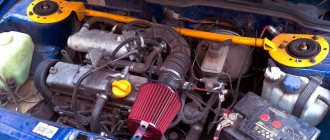The problem when a car loses speed is known to almost every car owner. This can happen almost both at start and while driving, when the car stalls when the speed decreases or jerks and stalls while driving.
Sometimes the car may start poorly or do so every once in a while, and then the engine stops starting altogether. But what are the reasons for this car behavior and how to eliminate them?
Why does the engine speed fluctuate?
There are few main reasons when the engine speed fluctuates, the engine adjusts or stops starting altogether. And most of them can be determined independently. Here are the most common of them:
- Faulty spark plugs or high-voltage wires. You may notice black soot or small streaks on the candles. And high-voltage wires are checked with a multimeter.
Which spark plugs are better, platinum or iridium?
If you connect this device to them, the readings should be 3.5 - 10 ohms. The exact data can be found on the wire markings or in the vehicle's operating instructions.
Also, sometimes in the dark when the engine is running you can see a spark on high voltages. In addition, it is not uncommon for them to have visible damage that is noticeable to the eye;
- Fuel filter . Sometimes it may be of poor quality initially or it has not been changed for too long;
- Injector clogged . To check it, it is advisable to carry out diagnostics at a service center;
- Faulty fuel pump . If it fails, the dynamics may also deteriorate or the car will begin to slow down and accelerate on its own while driving. Also, over time, it will start up worse and worse;
- Speed sensor . This reason is typical for some domestic cars. Its sign is also an independent increase in revolutions from approximately 850 to 1000-1100;
- Incorrect carburetor adjustment or clogging . Naturally, this applies only to carburetor cars, which are still in small numbers on Russian roads.
A drop in speed and pedal failure during sudden acceleration - reasons
Full operation of the power unit is achieved only if all its systems are functioning normally. This explains the need to constantly monitor the condition of the fuel system, engine and related parts. If all components and assemblies are in good working order, the speed will be easily gained and lost, depending on the driver’s actions. If there is any malfunction in the system, it can manifest itself in different ways. One of the most common problems is that when you press the gas pedal sharply, it fails and the vehicle begins to jerk. Let's look at what this phenomenon may mean and how to solve the problem yourself.
If, while pressing the gas pedal, the pedal itself fails and the speed decreases, this indicates that the operation of the components in the fuel system is incorrect
First, it’s worth understanding why the gas pedal fails. This is the first sign that the engine is not responding to the need to accelerate. This phenomenon can occur in various driving modes, and not only when the gas pedal is pressed sharply. In some cases, the car may simply stop. It is worth knowing the main signs that indicate the presence of malfunctions in the system: 1. Short dips of up to 3 seconds. 2. Deep dips for up to 10 seconds until the car comes to a complete stop. 3. Jerks. 4. Body twitching in the form of several jerks and a rapid decrease in speed. 5. Rocking the car.
Reasons for the drop in speed . If, while pressing the gas pedal, the pedal itself fails and the speed decreases, this indicates that the operation of the components in the fuel system is incorrect. Similar phenomena most often occur on carburetor engines. There is a certain sequence of actions that should be followed when such a phenomenon occurs:
- Check the system that supplies fuel to the carburetor. Pay special attention to the sprayer, channels and valves.
- Check the filter located at the outlet. If there is dirt in this element, it can hinder the flow of fuel, causing the fuel level in the stabilization chambers to decrease.
- Check the fuel pump and its fine filter.
Another manifestation of the malfunction occurs at zero load, when the gas pedal is depressed and a stable failure occurs for a long time.
The reason for the constant failure of the gas pedal . This phenomenon cannot be called homogeneous and it also differs in the principle of manifestation and duration. For example, short jerks may occur if the car starts to move away. The main reason is clogging of the first chamber or its outlet openings. Dips can be longer and accompanied by twitching, occurring at low speed. If such signs do not appear when you actively press the gas pedal, there is likely a problem with the jet. This element may become clogged or not tighten completely.
Another manifestation of the malfunction occurs at zero load, when the gas pedal is depressed and a stable failure occurs for a long time. This indicates a problem with the nozzle or idle channels. You can solve the problem yourself, but to do this you need to diagnose the cause: 1) Eliminate the possibility of air leaks; 2) Inspect the connection point of the fuel pump pipe; 3) Check the EPH valve.
If there are failures when pressing the gas pedal, you need to check the fine filter, which can become clogged during operation.
If a drop in speed when pressing the gas pedal is observed in fuel-injected cars, you should look for the cause in a different way. It is necessary to check the fine filter, which may become clogged during operation. In addition, the reason for the drop in speed can be a non-working fuel pump, filter mesh, low pressure in the fuel system, faulty sensors, clogged throttle valve and worn injectors.
Bottom line . Dips and drops in speed when pressing the gas pedal can indicate serious problems in the vehicle’s fuel system. The cause should be determined in time so as not to harm the vehicle engine.
What to do if the engine speed fluctuates
You can fix most problems associated with a drop in speed on your own.
Most often you have to change spark plugs, high-voltage wires or a fuel filter.
Often the fuel pump or speed sensor on a Russian-made car may require replacement.
With the proper experience, you can perform injector flushing and carburetor adjustments on your own. But in the absence of it, it is better to entrust this work to specialists.
What are the reasons for the drop in turnover?
Many car enthusiasts do not pay attention to the condition of their cars, much less the engine. Often, the consequences can be expressed in malfunctions, which will develop into major repairs, which will cost a considerable amount of money . It is for these reasons that if a malfunction occurs with the engine, it is necessary to return it to normal functionality.
So, let's look at the main reasons that lead to low idle speed:
- The adjustment of the “quantity” and “quality” screws is broken
A common cause of low idle speed on Ozone carburetors. Often, tightening the fuel adjustment screws is enough to restore normal speed.
- Fuel level is incorrectly adjusted
In addition to a drop in engine speed at idle, this leads to a drop in power. The engine may stall or start after much suffering. Long-term operation on lean fuel can lead to engine failure.
- Foreign air enters the carburetor
The “suction” of excess air can interfere with engine operation. Another option is that the air filter is dirty and not enough air is getting in.
- Poor quality fuel
Engines designed to consume high-quality fuel may malfunction or fail if they are “fed” with lower quality fuel, for example, 92 instead of 95. Moreover, the engine may encounter a lot of new problems that will have to be solved, so it is better to use good gasoline.
- On-board computer malfunctions
It also happens that the on-board computer begins to show inaccurate data. If everything seems to be fine with the engine, but the electronics persistently indicate that there is a problem, you can try to connect a working BC and check it on it.
- It's time to change the spark plugs
Determining the cause of the malfunction
The following steps will help you determine the reason why the idle speed has dropped.
- If there are no additional signs of a drop in speed (for example, vibration), you can check the engine on another on-board computer.
- Check sensors.
- Inspect the spark plugs.
- Make sure the fuel and idle levels are adjusted correctly
- Make sure that excess air is not “sucked” into the carburetor.
- Inspect the air filter for contamination.
The origins of unstable engine operation at XX
How will the picture develop if the control unit does not receive data on the quantity and volume of air consumed? So, for example, the reaction of the throttle sensor will be as follows - the speed will initially increase, but then the fuel mixture will begin to become leaner, as a result of which low speed will be established on a hot engine. There is only one reason for this - the amount of air consumed by the engine has decreased.
However, the opposite happens - the fuel mixture becomes richer, and the engine begins to gain speed again. Such cycles can alternate endlessly; these are floating revolutions. The problem of low idle speed on a warm engine in winter is especially pressing.
On some cars, events may develop differently - the speed increases, for example, to 2000 rpm, but remains there. The reason is that the injector injects increased amounts of fuel. The amount of air does not increase, otherwise the engine would be able to increase the speed to 3 thousand, however, then it would still start to stall.
Idle air control valve or IAC
The IAC is a small electric motor in which a cone-shaped needle is placed on a spring. It is designed to supply air to the engine power system, which is necessary to form the proper quality of the air-fuel mixture, making it lean. It is connected to the mass air flow sensor and, receiving a signal from the ECU, opens, providing air flow without using the throttle valve, which changes position when the gas pedal is pressed.
Having rather fragile parts and being located in the engine intake manifold, the regulator is subject to the formation of various deposits on the needle, which impedes its movement, which leads to failure of this part.
Checking the performance of the IAC is quite simple; to do this, you need to use a tester and check its resistance readings on a warm engine. The operating resistance should be in the range from 40 to 80 ohms. If it is not, then it is faulty and needs to be replaced.
Another characteristic sign of a regulator failure is that when the engine is hot, it begins to stall as soon as the gearbox is switched off while driving.
The IAC cannot be repaired, so it is simply replaced with a new part. If the regulator resistance indicator is normal, then it is worth checking the mass air flow sensor.
Air filter
The situation is similar as in the case of a gasoline filter element. Please note that the operation and repair of the vehicle must be carried out in accordance with the manufacturer's requirements. After all, you know that a mixture of gasoline and air is supplied to the combustion chamber. Consequently, if any component of this mixture does not enter the fuel rail, the engine will stall. Consider an example of how a motor operates when there is not enough air. Too rich a mixture enters the combustion chamber, causing the spark plugs to flood. At the same time, there is a feeling as if the engine does not have enough air, it is suffocating. Among other things, some motorists who do not know about the principle of operation of an internal combustion engine can cover the inlet pipe with a rag to prevent water from getting into it. It's funny, but this happens.
Conclusion
A drop in engine speed is a fairly common problem. It can happen not only for any one reason - when the engine is severely worn out, an integrated approach is required, and the breakdowns can be quite specific. In this case, you may need to seek professional help.
Many owners of injection cars could observe the effects when the speed suddenly drops at idle. This phenomenon occurs especially often when the engine is warmed up to operating temperatures. Sometimes the revs drop so low that the engine stalls. Let's figure out what can cause low idle speeds on a warm engine, and also find out why they drop. This information will be useful to everyone.
How to prevent air leaks?
In order to exclude or confirm the leakage of excess unaccounted air into the system, check the tightness of the air supply system.
Read also: Voltage of a charged battery
To do this, you can remove the air pipe and blow into it from a compressor or pump. The hose can be placed in water. This will reveal cracks and other defects.
Spark plug
To make sure the spark plugs are working properly, you need to unscrew them all, check the gap size, as well as the presence of carbon deposits. And your car stalls while driving. The reason may be hidden in the candles. If there is heavy carbon deposits, but the gap is within acceptable values, it is necessary to clean the spark plug electrodes. But the best way out is to install new spark plugs. In the same case, if the gap is very large, there is excessive wear of the electrode, cleaning will not help, it is necessary to completely replace the set of spark plugs.
Idle air control valve or IAC
The IAC is a small electric motor in which a cone-shaped needle is placed on a spring. It is designed to supply air to the engine power system, which is necessary to form the proper quality of the air-fuel mixture, making it lean. It is connected to the mass air flow sensor and, receiving a signal from the ECU, opens, providing air flow without using the throttle valve, which changes position when the gas pedal is pressed.
Having rather fragile parts and being located in the engine intake manifold, the regulator is subject to the formation of various deposits on the needle, which impedes its movement, which leads to failure of this part.
Checking the performance of the IAC is quite simple; to do this, you need to use a tester and check its resistance readings on a warm engine. The operating resistance should be in the range from 40 to 80 ohms. If it is not, then it is faulty and needs to be replaced.
Another characteristic sign of a regulator failure is that when the engine is hot, it begins to stall as soon as the gearbox is switched off while driving.
The IAC cannot be repaired, so it is simply replaced with a new part. If the regulator resistance indicator is normal, then it is worth checking the mass air flow sensor.

